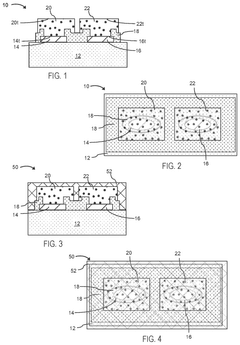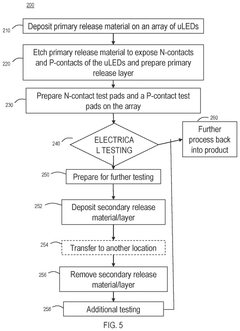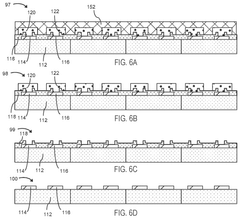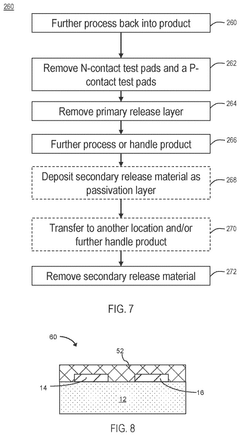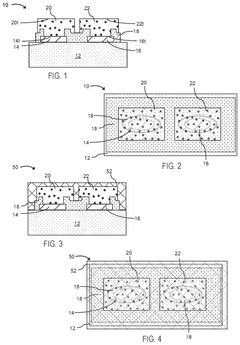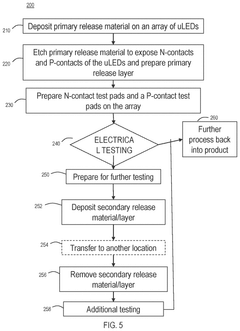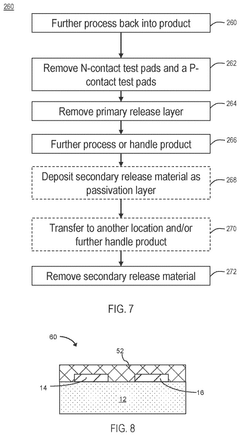How to Secure Funding for ULED Research Projects?
JUN 20, 20259 MIN READ
Generate Your Research Report Instantly with AI Agent
Patsnap Eureka helps you evaluate technical feasibility & market potential.
ULED Research Landscape
The ULED (Ultra-Low Energy Devices) research landscape is characterized by a dynamic and rapidly evolving field at the intersection of materials science, electronics, and energy efficiency. This area has gained significant attention in recent years due to the growing demand for energy-efficient technologies across various sectors, including consumer electronics, industrial applications, and IoT devices.
ULED research primarily focuses on developing novel materials and device architectures that can operate at ultra-low power levels while maintaining or improving performance. Key areas of investigation include advanced semiconductor materials, nanoscale fabrication techniques, and innovative circuit designs. The field is driven by the need to address the increasing energy consumption of electronic devices and the global push towards sustainable technologies.
One of the primary challenges in ULED research is the development of materials that can function effectively at extremely low voltages. This involves exploring new classes of semiconductors, such as two-dimensional materials like graphene and transition metal dichalcogenides, as well as organic semiconductors. These materials offer unique properties that could enable devices to operate at significantly lower power levels than traditional silicon-based electronics.
Another critical aspect of the ULED research landscape is the integration of novel device architectures. This includes the exploration of tunnel field-effect transistors (TFETs), negative capacitance FETs, and other emerging device concepts that can potentially overcome the fundamental limitations of conventional CMOS technology in terms of power consumption.
The ULED research community is highly interdisciplinary, involving collaboration between physicists, materials scientists, electrical engineers, and computer scientists. Major research institutions, universities, and technology companies worldwide are actively engaged in ULED-related projects, reflecting the global nature of this research field.
Funding for ULED research comes from various sources, including government agencies, private sector investments, and academic grants. In many countries, ULED research aligns with national priorities for energy efficiency and technological innovation, making it an attractive area for public funding. Additionally, the potential commercial applications of ULED technologies have attracted significant interest from industry partners, leading to collaborative research initiatives and private sector funding opportunities.
The ULED research landscape is also characterized by a strong focus on practical applications and commercialization potential. While fundamental research remains crucial, there is a growing emphasis on translating scientific discoveries into viable products and technologies. This has led to an increase in patent filings and start-up activities in the ULED space, as researchers and entrepreneurs seek to capitalize on breakthroughs in ultra-low energy device technology.
ULED research primarily focuses on developing novel materials and device architectures that can operate at ultra-low power levels while maintaining or improving performance. Key areas of investigation include advanced semiconductor materials, nanoscale fabrication techniques, and innovative circuit designs. The field is driven by the need to address the increasing energy consumption of electronic devices and the global push towards sustainable technologies.
One of the primary challenges in ULED research is the development of materials that can function effectively at extremely low voltages. This involves exploring new classes of semiconductors, such as two-dimensional materials like graphene and transition metal dichalcogenides, as well as organic semiconductors. These materials offer unique properties that could enable devices to operate at significantly lower power levels than traditional silicon-based electronics.
Another critical aspect of the ULED research landscape is the integration of novel device architectures. This includes the exploration of tunnel field-effect transistors (TFETs), negative capacitance FETs, and other emerging device concepts that can potentially overcome the fundamental limitations of conventional CMOS technology in terms of power consumption.
The ULED research community is highly interdisciplinary, involving collaboration between physicists, materials scientists, electrical engineers, and computer scientists. Major research institutions, universities, and technology companies worldwide are actively engaged in ULED-related projects, reflecting the global nature of this research field.
Funding for ULED research comes from various sources, including government agencies, private sector investments, and academic grants. In many countries, ULED research aligns with national priorities for energy efficiency and technological innovation, making it an attractive area for public funding. Additionally, the potential commercial applications of ULED technologies have attracted significant interest from industry partners, leading to collaborative research initiatives and private sector funding opportunities.
The ULED research landscape is also characterized by a strong focus on practical applications and commercialization potential. While fundamental research remains crucial, there is a growing emphasis on translating scientific discoveries into viable products and technologies. This has led to an increase in patent filings and start-up activities in the ULED space, as researchers and entrepreneurs seek to capitalize on breakthroughs in ultra-low energy device technology.
Funding Demand Analysis
The funding demand for ULED (Ultra-Light Emitting Diode) research projects has been steadily increasing in recent years, driven by the technology's potential to revolutionize display and lighting industries. Market analysis indicates a growing interest from both public and private sectors in supporting ULED development, recognizing its promise for energy efficiency and enhanced performance.
Government agencies, particularly those focused on energy and technology innovation, have shown a keen interest in funding ULED research. This is largely due to the technology's alignment with broader goals of reducing energy consumption and promoting sustainable technologies. In the United States, agencies such as the Department of Energy (DOE) and the National Science Foundation (NSF) have allocated significant resources to advanced lighting research, including ULED projects.
Private sector funding for ULED research has also seen an uptick, with major technology companies and venture capital firms recognizing the potential market value of ULED applications. The global display market, estimated to reach hundreds of billions of dollars in the coming years, presents a substantial opportunity for ULED technology. This has led to increased investment in research and development from companies in the consumer electronics, automotive, and lighting industries.
Academic institutions have reported a rise in research grants related to ULED technology, reflecting the growing academic interest and the potential for breakthrough discoveries. These grants often come from a combination of government sources, industry partnerships, and institutional funds, highlighting the collaborative nature of ULED research funding.
The funding landscape for ULED research is characterized by a mix of long-term strategic investments and shorter-term project-based funding. Long-term investments typically come from government agencies and large corporations aiming to establish a strong foundation in ULED technology. Project-based funding, on the other hand, often targets specific applications or technical challenges, attracting a diverse range of investors including smaller companies and specialized research funds.
Despite the growing interest, securing funding for ULED research projects remains competitive. Successful proposals often demonstrate clear potential for commercial applications, energy savings, or significant technological advancements. Interdisciplinary approaches that combine expertise in materials science, optoelectronics, and manufacturing processes are particularly attractive to funders, as they address the multifaceted challenges of ULED development.
The global nature of ULED research has also influenced funding patterns, with international collaborations becoming increasingly common. This trend has opened up new funding avenues, including joint research initiatives between countries and cross-border industry partnerships. Such collaborations not only pool financial resources but also leverage diverse expertise and research facilities.
Government agencies, particularly those focused on energy and technology innovation, have shown a keen interest in funding ULED research. This is largely due to the technology's alignment with broader goals of reducing energy consumption and promoting sustainable technologies. In the United States, agencies such as the Department of Energy (DOE) and the National Science Foundation (NSF) have allocated significant resources to advanced lighting research, including ULED projects.
Private sector funding for ULED research has also seen an uptick, with major technology companies and venture capital firms recognizing the potential market value of ULED applications. The global display market, estimated to reach hundreds of billions of dollars in the coming years, presents a substantial opportunity for ULED technology. This has led to increased investment in research and development from companies in the consumer electronics, automotive, and lighting industries.
Academic institutions have reported a rise in research grants related to ULED technology, reflecting the growing academic interest and the potential for breakthrough discoveries. These grants often come from a combination of government sources, industry partnerships, and institutional funds, highlighting the collaborative nature of ULED research funding.
The funding landscape for ULED research is characterized by a mix of long-term strategic investments and shorter-term project-based funding. Long-term investments typically come from government agencies and large corporations aiming to establish a strong foundation in ULED technology. Project-based funding, on the other hand, often targets specific applications or technical challenges, attracting a diverse range of investors including smaller companies and specialized research funds.
Despite the growing interest, securing funding for ULED research projects remains competitive. Successful proposals often demonstrate clear potential for commercial applications, energy savings, or significant technological advancements. Interdisciplinary approaches that combine expertise in materials science, optoelectronics, and manufacturing processes are particularly attractive to funders, as they address the multifaceted challenges of ULED development.
The global nature of ULED research has also influenced funding patterns, with international collaborations becoming increasingly common. This trend has opened up new funding avenues, including joint research initiatives between countries and cross-border industry partnerships. Such collaborations not only pool financial resources but also leverage diverse expertise and research facilities.
Current Challenges
Securing funding for ULED (Ultra-Low Energy Devices) research projects faces several significant challenges in the current landscape. The primary obstacle is the intense competition for limited research grants and funding resources. As ULED technology spans multiple disciplines, including materials science, electronics, and energy systems, it often competes with a wide range of other cutting-edge research areas for financial support.
The complexity and long-term nature of ULED research also present difficulties in attracting investors. Many funding bodies and private investors prefer projects with shorter timelines and more immediate returns on investment. ULED research, which often requires extensive fundamental research before practical applications can be developed, may struggle to demonstrate short-term commercial viability.
Another challenge lies in the rapidly evolving technological landscape. As new energy-efficient technologies emerge, funders may shift their focus to what they perceive as more promising or trendy areas. This constant flux in research priorities can make it challenging for ULED projects to maintain consistent funding streams over the extended periods necessary for significant breakthroughs.
The interdisciplinary nature of ULED research can also complicate funding efforts. Traditional funding mechanisms often operate within specific disciplinary boundaries, making it difficult for cross-disciplinary projects to fit neatly into established funding categories. This can result in ULED research falling between the cracks of different funding agencies or programs.
Regulatory uncertainties and changing policy landscapes add another layer of complexity. As governments and international bodies grapple with energy and environmental policies, the priorities for research funding can shift rapidly. ULED researchers must navigate these changing tides while making a compelling case for the long-term benefits of their work.
The high initial costs associated with ULED research infrastructure and specialized equipment can also deter potential funders. Without access to state-of-the-art facilities and tools, researchers may struggle to produce competitive results, creating a chicken-and-egg problem in securing initial funding to establish research capabilities.
Lastly, the challenge of effectively communicating the potential impact and benefits of ULED technology to non-specialist funders and policymakers cannot be underestimated. Translating complex scientific concepts into compelling narratives that resonate with diverse funding bodies requires skills that many researchers may need to develop or seek assistance with.
The complexity and long-term nature of ULED research also present difficulties in attracting investors. Many funding bodies and private investors prefer projects with shorter timelines and more immediate returns on investment. ULED research, which often requires extensive fundamental research before practical applications can be developed, may struggle to demonstrate short-term commercial viability.
Another challenge lies in the rapidly evolving technological landscape. As new energy-efficient technologies emerge, funders may shift their focus to what they perceive as more promising or trendy areas. This constant flux in research priorities can make it challenging for ULED projects to maintain consistent funding streams over the extended periods necessary for significant breakthroughs.
The interdisciplinary nature of ULED research can also complicate funding efforts. Traditional funding mechanisms often operate within specific disciplinary boundaries, making it difficult for cross-disciplinary projects to fit neatly into established funding categories. This can result in ULED research falling between the cracks of different funding agencies or programs.
Regulatory uncertainties and changing policy landscapes add another layer of complexity. As governments and international bodies grapple with energy and environmental policies, the priorities for research funding can shift rapidly. ULED researchers must navigate these changing tides while making a compelling case for the long-term benefits of their work.
The high initial costs associated with ULED research infrastructure and specialized equipment can also deter potential funders. Without access to state-of-the-art facilities and tools, researchers may struggle to produce competitive results, creating a chicken-and-egg problem in securing initial funding to establish research capabilities.
Lastly, the challenge of effectively communicating the potential impact and benefits of ULED technology to non-specialist funders and policymakers cannot be underestimated. Translating complex scientific concepts into compelling narratives that resonate with diverse funding bodies requires skills that many researchers may need to develop or seek assistance with.
Existing Funding Models
01 ULED structure and fabrication
Ultra-Light Emitting Diodes (ULEDs) are advanced semiconductor devices designed for high-efficiency light emission. Their structure typically involves multiple layers of semiconductor materials, including quantum wells for enhanced light output. Fabrication techniques focus on optimizing the epitaxial growth process and incorporating novel materials to improve performance.- ULED structure and composition: Ultra-Light Emitting Diodes (ULEDs) are advanced semiconductor devices designed for high-efficiency light emission. They typically consist of multiple layers of semiconductor materials, including quantum wells and barrier layers, to enhance light output and reduce power consumption. The structure may incorporate novel materials or nanostructures to improve performance.
- ULED manufacturing processes: Manufacturing techniques for ULEDs involve precise deposition and patterning of semiconductor layers. Advanced processes may include epitaxial growth, photolithography, and etching techniques to create nanoscale structures. Novel approaches to improve uniformity, reduce defects, and enhance light extraction efficiency are key aspects of ULED fabrication.
- ULED applications in displays: ULEDs are increasingly used in display technologies, offering advantages such as high brightness, low power consumption, and improved color gamut. They are particularly suitable for high-resolution displays in smartphones, televisions, and other electronic devices. Integration of ULEDs with display driving circuits and pixel architectures is a focus area for development.
- ULED packaging and thermal management: Packaging solutions for ULEDs are crucial for optimal performance and longevity. This includes developing heat-dissipation structures, protective encapsulations, and efficient electrical connections. Thermal management techniques are essential to maintain the stability and efficiency of ULEDs, especially in high-power applications.
- ULED color tuning and phosphor technologies: Color tuning in ULEDs involves techniques to achieve a wide range of colors and white light emission. This may include the use of phosphor materials, quantum dots, or multiple active regions emitting different wavelengths. Advanced phosphor technologies and color conversion methods are developed to enhance color rendering and efficiency in ULED-based lighting systems.
02 ULED applications in displays
ULEDs are increasingly used in display technologies, offering advantages such as high brightness, low power consumption, and improved color gamut. They are particularly suitable for micro-LED displays, where individual ULED pixels can be precisely controlled for enhanced image quality and energy efficiency.Expand Specific Solutions03 ULED packaging and thermal management
Effective packaging and thermal management are crucial for ULED performance and longevity. Advanced packaging techniques aim to improve heat dissipation, protect the device from environmental factors, and enhance overall reliability. This includes the development of novel substrate materials and integration of cooling mechanisms.Expand Specific Solutions04 ULED efficiency and light output optimization
Ongoing research focuses on improving the efficiency and light output of ULEDs. This involves optimizing the quantum well structure, enhancing carrier confinement, and reducing internal losses. Novel approaches include the use of nanostructures and advanced materials to increase light extraction efficiency.Expand Specific Solutions05 ULED integration with control circuits
The integration of ULEDs with sophisticated control circuits enables advanced functionalities such as precise dimming, color tuning, and dynamic response. This integration is crucial for applications in smart lighting systems and advanced display technologies, allowing for improved energy efficiency and user experience.Expand Specific Solutions
Key Funding Entities
The ULED research funding landscape is characterized by a competitive and evolving market, currently in its growth phase. With increasing demand for advanced display technologies, the market size for ULED research is expanding rapidly. The technology maturity varies among key players, with companies like Universal Display Corp., Lumileds LLC, and Osram International GmbH leading in innovation. Emerging contenders such as Appotronics Corp. Ltd. and Xiamen San'an Optoelectronics Co., Ltd. are also making significant strides. The involvement of academic institutions like Nanjing University of Posts & Telecommunications and Xi'an Jiaotong University indicates a strong focus on fundamental research, while industry giants like Huawei Technologies Co., Ltd. and Koninklijke Philips NV are driving commercial applications, creating a dynamic ecosystem for ULED development and funding opportunities.
Universal Display Corp.
Technical Solution: Universal Display Corporation (UDC) has developed a comprehensive strategy for securing funding for ULED research projects. Their approach includes a mix of internal R&D investment, strategic partnerships, and government grants. UDC allocates a significant portion of its annual revenue to ULED research, focusing on improving OLED efficiency and longevity. They also collaborate with academic institutions and other industry players to share research costs and accelerate innovation. Additionally, UDC actively pursues government funding opportunities, such as those offered by the U.S. Department of Energy, to support their ULED initiatives.
Strengths: Strong financial position, established industry reputation, and extensive patent portfolio. Weaknesses: Dependence on key customers and potential competition from alternative technologies.
Xiamen San'an Optoelectronics Co., Ltd.
Technical Solution: Xiamen San'an Optoelectronics has implemented a multi-faceted approach to secure funding for ULED research projects. The company leverages its position as a leading LED manufacturer in China to attract both private and public investments. They have established a dedicated ULED research division and allocate substantial resources from their operational profits to fund ongoing research. San'an also actively participates in government-sponsored initiatives, such as China's National High-tech R&D Program (863 Program), to secure additional funding. Furthermore, they have formed strategic alliances with universities and research institutions to pool resources and share research costs.
Strengths: Strong government support, vertically integrated manufacturing capabilities. Weaknesses: Intense domestic competition, potential intellectual property challenges in international markets.
Innovative Funding Strategies
Test Apparatus For Flip-Chip Micro-Light Emitting Diode (LED) Devices
PatentPendingUS20250038154A1
Innovation
- The solution involves creating micro-light emitting diode (uLED) devices with temporary, removable electrical test pads that allow for the measurement of absolute electrical properties without altering the pixel size or damaging it, and a testing apparatus that includes N-contact and P-contact test pad templates connected to testing buses.
Testable Flip-Chip Micro-Light Emitting Diode (LED) Devices
PatentPendingUS20250046660A1
Innovation
- The solution involves creating micro-light emitting diode (uLED) devices with temporary, removable electrical test pads that allow for the measurement of absolute electrical properties without altering the pixel size or damaging the uLEDs. This is achieved by depositing a primary release material, etching to expose the contacts, and preparing test pads on the uLEDs, which can be connected in parallel to testing buses for mass testing.
Policy and Regulations
Securing funding for ULED (Ultra-Low Energy Devices) research projects requires a thorough understanding of the policy and regulatory landscape. Government policies play a crucial role in shaping the funding environment for emerging technologies like ULED. In many countries, there are specific initiatives and programs aimed at promoting energy-efficient technologies, which can be leveraged for ULED research funding.
At the national level, energy policies often include provisions for research and development in low-energy technologies. These policies may set targets for energy efficiency improvements and allocate budgets for related research. Researchers and institutions seeking funding for ULED projects should align their proposals with these national priorities to increase their chances of success.
Regulatory frameworks also impact the funding landscape for ULED research. Environmental regulations, such as those limiting carbon emissions or mandating energy efficiency standards, can create incentives for investment in ULED technologies. Understanding these regulations and demonstrating how ULED research contributes to compliance can strengthen funding applications.
International agreements and collaborations can provide additional funding opportunities for ULED research. Many countries participate in global initiatives to combat climate change and promote sustainable development. These agreements often include provisions for technology transfer and joint research efforts, which can be tapped into for ULED projects.
Intellectual property regulations are another critical aspect to consider when seeking funding for ULED research. Clear and robust IP protection can attract private investment, as it ensures that the outcomes of the research can be commercialized. Researchers should be familiar with patent laws and licensing agreements to effectively navigate this aspect of funding acquisition.
Funding agencies and grant-making bodies often have specific guidelines and requirements for research proposals. These may include ethical considerations, environmental impact assessments, and technology readiness levels. ULED researchers must carefully review and adhere to these guidelines to maximize their chances of securing funding.
Regulatory bodies overseeing the electronics and semiconductor industries may also influence funding opportunities for ULED research. Compliance with industry standards and regulations is often a prerequisite for funding eligibility. Researchers should stay informed about relevant industry regulations and demonstrate how their projects align with or advance these standards.
In conclusion, navigating the policy and regulatory landscape is essential for securing funding for ULED research projects. A comprehensive understanding of national and international policies, regulatory frameworks, and industry standards can significantly enhance the prospects of obtaining financial support for innovative ULED technologies.
At the national level, energy policies often include provisions for research and development in low-energy technologies. These policies may set targets for energy efficiency improvements and allocate budgets for related research. Researchers and institutions seeking funding for ULED projects should align their proposals with these national priorities to increase their chances of success.
Regulatory frameworks also impact the funding landscape for ULED research. Environmental regulations, such as those limiting carbon emissions or mandating energy efficiency standards, can create incentives for investment in ULED technologies. Understanding these regulations and demonstrating how ULED research contributes to compliance can strengthen funding applications.
International agreements and collaborations can provide additional funding opportunities for ULED research. Many countries participate in global initiatives to combat climate change and promote sustainable development. These agreements often include provisions for technology transfer and joint research efforts, which can be tapped into for ULED projects.
Intellectual property regulations are another critical aspect to consider when seeking funding for ULED research. Clear and robust IP protection can attract private investment, as it ensures that the outcomes of the research can be commercialized. Researchers should be familiar with patent laws and licensing agreements to effectively navigate this aspect of funding acquisition.
Funding agencies and grant-making bodies often have specific guidelines and requirements for research proposals. These may include ethical considerations, environmental impact assessments, and technology readiness levels. ULED researchers must carefully review and adhere to these guidelines to maximize their chances of securing funding.
Regulatory bodies overseeing the electronics and semiconductor industries may also influence funding opportunities for ULED research. Compliance with industry standards and regulations is often a prerequisite for funding eligibility. Researchers should stay informed about relevant industry regulations and demonstrate how their projects align with or advance these standards.
In conclusion, navigating the policy and regulatory landscape is essential for securing funding for ULED research projects. A comprehensive understanding of national and international policies, regulatory frameworks, and industry standards can significantly enhance the prospects of obtaining financial support for innovative ULED technologies.
Collaborative Opportunities
Collaborative opportunities play a crucial role in securing funding for ULED research projects. By fostering partnerships with various stakeholders, researchers can enhance their chances of obtaining financial support and resources necessary for advancing ULED technology.
One of the most promising avenues for collaboration is through industry-academia partnerships. Many companies in the lighting and display sectors are keen to invest in cutting-edge ULED research, as it has the potential to revolutionize their product offerings. By aligning research goals with industry needs, academic institutions can attract substantial funding from corporate sponsors. These partnerships often lead to joint patent applications and technology transfer agreements, further incentivizing investment.
Government agencies and research foundations also present significant collaborative opportunities. Many countries have established initiatives to promote energy-efficient technologies, making ULED research an attractive candidate for public funding. Researchers can leverage these programs by forming consortia with other institutions and presenting comprehensive proposals that address national priorities in energy conservation and technological innovation.
International collaborations can open doors to diverse funding sources and expertise. By partnering with research teams from different countries, ULED projects can tap into multiple national funding schemes and benefit from complementary skills and resources. Such collaborations often lead to more robust research outcomes and increased visibility in the global scientific community.
Interdisciplinary collaborations within academic institutions can strengthen ULED research proposals. By integrating expertise from fields such as materials science, electrical engineering, and photonics, researchers can develop more comprehensive and innovative approaches to ULED technology. This multidisciplinary approach is often viewed favorably by funding bodies, as it demonstrates the potential for broader scientific impact.
Engaging with end-users and potential adopters of ULED technology can also enhance funding prospects. Collaborations with architectural firms, automotive manufacturers, or consumer electronics companies can provide valuable insights into market needs and practical applications. This user-centric approach can make research proposals more compelling to both public and private funding sources.
Lastly, partnerships with technology incubators and startup accelerators can provide alternative funding pathways for ULED research. These entities often have access to venture capital and can help researchers commercialize their innovations. By collaborating with such organizations, ULED projects can secure seed funding and gain valuable entrepreneurial support, potentially leading to the creation of spin-off companies and attracting further investment.
One of the most promising avenues for collaboration is through industry-academia partnerships. Many companies in the lighting and display sectors are keen to invest in cutting-edge ULED research, as it has the potential to revolutionize their product offerings. By aligning research goals with industry needs, academic institutions can attract substantial funding from corporate sponsors. These partnerships often lead to joint patent applications and technology transfer agreements, further incentivizing investment.
Government agencies and research foundations also present significant collaborative opportunities. Many countries have established initiatives to promote energy-efficient technologies, making ULED research an attractive candidate for public funding. Researchers can leverage these programs by forming consortia with other institutions and presenting comprehensive proposals that address national priorities in energy conservation and technological innovation.
International collaborations can open doors to diverse funding sources and expertise. By partnering with research teams from different countries, ULED projects can tap into multiple national funding schemes and benefit from complementary skills and resources. Such collaborations often lead to more robust research outcomes and increased visibility in the global scientific community.
Interdisciplinary collaborations within academic institutions can strengthen ULED research proposals. By integrating expertise from fields such as materials science, electrical engineering, and photonics, researchers can develop more comprehensive and innovative approaches to ULED technology. This multidisciplinary approach is often viewed favorably by funding bodies, as it demonstrates the potential for broader scientific impact.
Engaging with end-users and potential adopters of ULED technology can also enhance funding prospects. Collaborations with architectural firms, automotive manufacturers, or consumer electronics companies can provide valuable insights into market needs and practical applications. This user-centric approach can make research proposals more compelling to both public and private funding sources.
Lastly, partnerships with technology incubators and startup accelerators can provide alternative funding pathways for ULED research. These entities often have access to venture capital and can help researchers commercialize their innovations. By collaborating with such organizations, ULED projects can secure seed funding and gain valuable entrepreneurial support, potentially leading to the creation of spin-off companies and attracting further investment.
Unlock deeper insights with Patsnap Eureka Quick Research — get a full tech report to explore trends and direct your research. Try now!
Generate Your Research Report Instantly with AI Agent
Supercharge your innovation with Patsnap Eureka AI Agent Platform!
